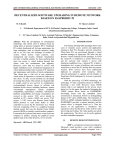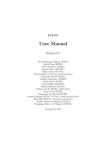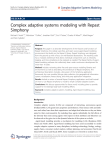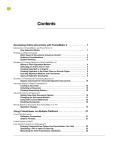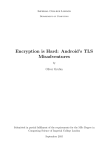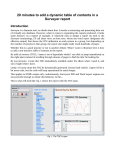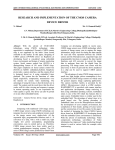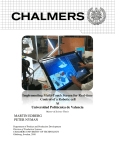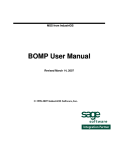Download Garbage Collection Programming Guide (Retired
Transcript
Garbage Collection
Programming Guide
(Retired Document)
Contents
Introduction to Garbage Collection 6
Who Should Read This Document? 6
Organization of This Document 6
See Also 7
Garbage Collection for Cocoa Essentials 8
Basic Concepts 8
How the Garbage Collector Works 8
Root Set and Reference Types 9
Enabling Garbage Collection 10
Foundation Tools 11
Design Patterns to Use, and to Avoid 12
Finalizing objects 12
Don't manage scarce resources with object lifecycle 12
Nib files 12
Triggering garbage collection 13
Threading 13
Prune caches 13
Avoid allocating large numbers of short-lived objects 13
Compile GC-Only 13
C++ 13
Adopting Garbage Collection 14
Advantages and Disadvantages 14
Performance 15
Architecture 17
Motivation and Design Goals 17
High-Level Architecture 20
How the Garbage Collector Works 20
Closed vs. Open Systems 22
Write Barriers 22
What Does a Write-Barrier Do? 23
Write-Barrier Implementation 23
Retired Document | 2012-07-23 | Copyright © 2012 Apple Inc. All Rights Reserved.
2
Using Garbage Collection 25
Cycles 25
Weak and Zeroing Weak References 25
Managing Opaque Pointers 25
Global Object Pointers 28
Interior Pointers 29
Compiler Flag 31
Implementing a finalize Method 32
Design Patterns 32
Efficiency 32
Messaging Other Objects 33
Avoiding Resurrection 33
Managing an External Resource 34
Inapplicable Patterns 36
Reference counting 36
dealloc 36
Enumerations 37
Resource wrapper objects 37
Leaked but not lost objects 38
Delegate references 38
Memory zones 38
Using Core Foundation with Garbage Collection 39
Allocation 39
Memory Management Semantics 39
Core Foundation Variables 42
Instance variables 42
Local Variables 43
Core Foundation Collection Semantics 44
Garbage Collection API 46
Foundation 46
NSObject 46
NSAutoreleasePool 46
NSGarbageCollector 47
Collection Classes 47
NSValue 47
NSThread 47
Retired Document | 2012-07-23 | Copyright © 2012 Apple Inc. All Rights Reserved.
3
Foundation Functions 48
Core Foundation 48
CFMutableArray 48
CFMutableDictionary 48
Core Foundation Functions 49
Language Support 49
Runtime 50
Document Revision History 52
Retired Document | 2012-07-23 | Copyright © 2012 Apple Inc. All Rights Reserved.
4
Figures and Listings
Garbage Collection for Cocoa Essentials 8
Figure 1
Xcode code generation build settings for garbage collection 11
Architecture 17
Figure 1
Listing 1
Scanned and unscanned memory 21
Full-featured implementation of the Widget class 18
Retired Document | 2012-07-23 | Copyright © 2012 Apple Inc. All Rights Reserved.
5
Introduction to Garbage Collection
Important: Garbage Collection is deprecated in OS X v10.8. Instead, you should use Automatic Reference
Counting—see Transitioning to ARC Release Notes .
In OS X, you can write programs that make use of an automatic memory management system commonly
known as “garbage collection.” (Garbage collection is not available in iOS.) Garbage collection coexists with
the traditional system of memory management (that uses manual reference counting using retain, release,
and autorelease pools)—herein referred to as “manually reference counted”—and is hence an opt-in system.
These documents describe the complete garbage collection system provided for Cocoa, the functionality
provided, and some of the issues that arise if you adopt this technology.
Who Should Read This Document?
If you are developing applications using Cocoa, you should read at least Garbage Collection for Cocoa
Essentials (page 8) to gain an understanding of the garbage collection system. It is strongly recommended
that you also read Adopting Garbage Collection (page 14) and Implementing a finalize Method (page 32).
You are expected to already understand the Objective-C language (see The Objective-C Programming Language )
and to have some familiarity with Cocoa.
Organization of This Document
The following articles explain the problems the garbage collection system addresses, the solutions it provides,
its basic functionality, and common tasks you might perform:
●
Garbage Collection for Cocoa Essentials (page 8) describes the essential details of the garbage collection
system for Cocoa. At a minimum, you should read this article.
●
Adopting Garbage Collection (page 14) describes issues related to adopting garbage collection.
●
Architecture (page 17) describes the design goals and architecture of the technology, and the benefits
you get from using it.
●
Using Garbage Collection (page 25) describes some of the features you can take advantage of when you
use garbage collection, and some of subtleties you need to be aware of.
Retired Document | 2012-07-23 | Copyright © 2012 Apple Inc. All Rights Reserved.
6
Introduction to Garbage Collection
See Also
●
Implementing a finalize Method (page 32) describes how to correctly implement a finalize method.
●
Inapplicable Patterns (page 36) describes Cocoa programming patterns that are not applicable to garbage
collection.
●
Using Core Foundation with Garbage Collection (page 39) describes how to use Core Foundation objects
with garbage collection.
●
Garbage Collection API (page 46) provides a summary of API used in garbage collection.
See Also
The following documents provide information about related aspects of Cocoa and the Objective-C language.
●
The Objective-C Programming Language describes object-oriented programming and describes the
Objective-C programming language.
●
Objective-C Runtime Reference describes the data structures and functions of the Objective-C runtime
support library.
●
Transitioning to ARC Release Notes provides information adopting Automatic Reference Counting.
Retired Document | 2012-07-23 | Copyright © 2012 Apple Inc. All Rights Reserved.
7
Garbage Collection for Cocoa Essentials
This article describes the basic concepts and features of the garbage collection technology that are essential
for a Cocoa developer to understand. It does not provide a complete treatment of the subject—you are expected
to read the other articles in this document to gain a deeper understanding. In particular, you should also read
Implementing a finalize Method (page 32).
Basic Concepts
When you use the Cocoa garbage collection technology, it manages your application's memory for you. All
Cocoa objects are garbage collected. There is no need to explicitly manage objects' retain counts to ensure
that they remain "live" or that the memory they take up is reclaimed when they are no longer used. For example,
with garbage collection enabled the following method (although inefficient!) does not result in any memory
leaks:
- (NSString *)fullName {
NSMutableString *mString = [[NSMutableString alloc] init];
if ([self firstName] != nil)
[mString appendString:[self firstName]];
if (([self firstName] != nil) && ([self lastName] != nil))
[mString appendString:@" "];
if ([self lastName] != nil)
[mString appendString:[self lastName]];
return [mString copy];
}
How the Garbage Collector Works
The garbage collector's goal is to form a set of reachable objects that constitute the "valid" objects in your
application, and then to discard any others. When a collection is initiated, the collector initializes the set with
all well-known root objects. The collector then recursively follows strong references from these objects to other
Retired Document | 2012-07-23 | Copyright © 2012 Apple Inc. All Rights Reserved.
8
Garbage Collection for Cocoa Essentials
Basic Concepts
objects, and adds these to the set. At the end of the process, all objects that are not reachable through a chain
of strong references to objects in the root set are designated as "garbage." At the end of the collection sequence,
the unreachable objects are finalized and immediately afterwards the memory they occupy is recovered.
Root Set and Reference Types
The initial root set of objects is comprised of global variables, stack variables, and objects with external references
(for more details about globals, see Global Object Pointers (page 28)). These objects are never considered as
garbage. The root set is comprised of all objects reachable from root objects and all possible references found
by examining the call stacks of every Cocoa thread.
Important: Note that the optimizing compiler can greatly reduce the lifespan of variables on the stack,
reusing stack slots as it determines that slot is no longer used by the code. This can result in objects being
collected more quickly than you might expect—see for example Interior Pointers (page 29).
Conversely, there may be situations in which you inadvertently leave references beyond the top of the
stack which the collector might so consider live and hence delay collection of the corresponding objects.
For more details, see objc_clear_stack in Language Support (page 49).
As implied earlier, there are two types of reference between objects—strong and weak. A strong reference is
visible to the collector, a weak reference is not. A non-root object is only live if it can be reached via strong
references from a root object. An important corollary is that simply because you have a strong reference to an
object does not mean that that object will survive garbage collection, as illustrated in the following figure.
NSApp
D
A
C
B
E
F
X
H
G
There is a strong reference from a global object (the shared NSApplication instance) to object A, which in
turn has a strong reference to B, which has a strong reference to C. All of these objects are therefore valid.
There is a weak reference from B to X, therefore X will be treated as garbage.
Retired Document | 2012-07-23 | Copyright © 2012 Apple Inc. All Rights Reserved.
9
Garbage Collection for Cocoa Essentials
Enabling Garbage Collection
There is a strong reference from D to E, but since neither has a strong reference from a root object, both are
treated as garbage. As an extension of the latter case, objects F, G, and H illustrate a retain cycle. In
reference-counted applications this may be a problem (see Object Ownership and Disposal); in a garbage
collected application, since none of these objects has a strong reference from a root object all are treated as
garbage and all are properly reclaimed.
All references to objects (id, NSObject *, and so on) are considered strong by default. Objects have strong
behavior, but so can other memory blocks and Core Foundation-style objects. You can create a weak reference
using the keyword __weak, or by adding objects to a collection configured to use weak references (such as
NSHashTable and NSMapTable).
Enabling Garbage Collection
Garbage collection is an optional feature; you need to set an appropriate flag for the compiler to mark code
as being GC capable. The compiler will then use garbage collector write-barrier assignment primitives within
the Objective-C runtime. An application marked GC capable will be started by the runtime with garbage
collection enabled.
There are three possible compiler settings:
●
No flag. This means that GC is not supported.
●
-fobjc-gc-only This means that only GC logic is present.
Code compiled as GC Required is presumed to not use traditional Cocoa retain/release methods and may
not be loaded into an application that is not running with garbage collection enabled.
●
-fobjc-gc This means that both GC and retain/release logic is present.
Code compiled as GC Supported is presumed to also contain traditional retain/release method logic and
can be loaded into any application.
Retired Document | 2012-07-23 | Copyright © 2012 Apple Inc. All Rights Reserved.
10
Garbage Collection for Cocoa Essentials
Foundation Tools
You can choose an option most easily by selecting the appropriate build setting in Xcode, as illustrated in
Figure 1 (page 11).
Figure 1
Xcode code generation build settings for garbage collection
Foundation Tools
In a Cocoa desktop application, the garbage collector is automatically started and run for you. If you are writing
a Foundation tool, you need to start the collector thread manually using the function
objc_startCollectorThread:
#import <objc/objc-auto.h>
int main (int argc, const char * argv[]) {
objc_startCollectorThread();
// your code
Retired Document | 2012-07-23 | Copyright © 2012 Apple Inc. All Rights Reserved.
11
Garbage Collection for Cocoa Essentials
Design Patterns to Use, and to Avoid
return 0;
}
You may want to occasionally clear the stack using objc_clear_stack() to ensure that nothing is falsely
rooted on the stack. You should typically do this when the stack is as shallow as possible—for example, at the
top of a processing loop.
You can also use objc_collect(OBJC_COLLECT_IF_NEEDED) to provide a hint to the collector that collection
might be appropriate—for example, after you finish using a large number of temporary objects.
Design Patterns to Use, and to Avoid
Don't try to optimize details in advance.
Finalizing objects
In a garbage-collected application, you should ideally ensure that any external resources held by an object
(such as open file descriptors) are closed prior to an object’s destruction. If you do need to perform some
operations just before an object is reclaimed, you should do so in a finalize method. For more details, see
Implementing a finalize Method (page 32). Note that you should never invoke finalize directly (except to
invoke super’s implementation in the finalize method itself ).
Don't manage scarce resources with object lifecycle
If an object holds on to a scarce resource, such as a file descriptor, you should indicate that the resource is no
longer required using an invalidation method. You should not wait until the object is collected and release
the resource in finalize. For more details, again see Implementing a finalize Method (page 32).
Nib files
Since the collector follows strong references from root objects, and treats as garbage all objects that cannot
be reached from a root object, you must ensure that there are strong references to all top-level objects in a
nib file (including for example, stand-alone controllers)—otherwise they will be collected. You can create a
strong reference simply by adding an outlet to the File's Owner and connecting it to a top-level object. (In
practice this is rarely likely to be an issue.)
Retired Document | 2012-07-23 | Copyright © 2012 Apple Inc. All Rights Reserved.
12
Garbage Collection for Cocoa Essentials
Design Patterns to Use, and to Avoid
Triggering garbage collection
In a standard application, Cocoa automatically hints at a suitable point in the event cycle that collection may
be appropriate. The collector then initiates collection if memory load exceeds a threshold. Typically this should
be sufficient to provide good performance. Sometimes, however, you may provide a hint to the collector that
collection may be warranted—for example after a loop in which you create a large number of temporary
objects. You can do this using the NSGarbageCollector method collectIfNeeded.
// Create temporary objects
NSGarbageCollector *collector = [NSGarbageCollector defaultCollector];
[collector collectIfNeeded];
Threading
Garbage collection is performed on its own thread—a thread is explicitly registered with the collector if it calls
NSThread's currentThread method (or if it uses an autorelease pool). There is no other explicit API for
registering a pthread with the collector.
Prune caches
The collector scans memory to find reachable objects, so by definition keeps the working set hot. You should
therefore make sure you get rid of objects you don't need.
Avoid allocating large numbers of short-lived objects
Object allocation is no less expensive an operation in a garbage collected environment than in a
reference-counted environment. You should avoid creating large numbers of (typically short-lived) objects.
Compile GC-Only
In general, you should not try to design your application to be dual-mode (that is, to support both garbage
collection and reference-counted environments). The exception is if you are developing frameworks and you
expect clients to operate in either mode.
C++
In general, C++ code should remain unchanged: you can assume memory allocated from standard malloc
zone. If you need to ensure the longevity of Objective-C objects, you should use CFRetain instead of retain.
Retired Document | 2012-07-23 | Copyright © 2012 Apple Inc. All Rights Reserved.
13
Adopting Garbage Collection
Garbage collection provides trade-offs that you need to consider when choosing whether to adopt the
technology.
Potentially, any application that uses a runloop may use garbage collection, however there are issues you
should consider when deciding whether it is appropriate for your application. Garbage collection provides
several advantages when compared with manual reference counting—although some of these are diminished
or negated with Automatic Reference Counting (ARC—see Transitioning to ARC Release Notes ); there are also,
though, some disadvantages. The benefits tend to be greater if the application is threaded and has a reasonably
large working set; they tend to be less if the latency of memory recovery is important. Moreover,
reference-counted and garbage collected applications use a number of different idioms and patterns.
Note: The process of migrating a large project that uses reference counting can be difficult and
error-prone—some patterns that work correctly with manual memory management will be incorrect
after translation. In general, it is recommended that you use garbage collection only in new projects.
If you already have a well-architected, well-understood application that uses reference counting,
there should be little reason to migrate to GC.
Advantages and Disadvantages
Garbage collection offers some significant advantages over a manually reference-counted environment (as
described in Advanced Memory Management Programming Guide ):
●
Most obviously, it typically simplifies the task of managing memory in your application and obviates most
of the memory-related problems that occur, such as retain cycles.
●
It reduces the amount of code you have to write and maintain, and may make some aspects of development
easier—for example, zeroing weak references facilitate use of objects that may disappear.
●
It usually makes it easier to write multi-threaded code: you do not have to use locks to ensure the atomicity
of accessor methods and you do not have to deal with per-thread autorelease pools. (Note that although
garbage collection simplifies some aspects of multi-threaded programming, it does not automatically
make your application thread-safe. For more about thread-safe application development, see Threading
Programming Guide .)
Retired Document | 2012-07-23 | Copyright © 2012 Apple Inc. All Rights Reserved.
14
Adopting Garbage Collection
Performance
Garbage collection does though have some disadvantages:
●
The application’s working set may be larger.
●
Performance may not be as good as if you hand-optimize memory management (for more details, see
Performance (page 15)).
●
A common design pattern whereby resources are tied to the lifetime of objects does not work effectively
under GC.
●
You must ensure that for any object you want to be long-lived you maintain a chain of strong references
to it from a root object, or resort to reference counting for that object.
●
Not all frameworks and technologies support garbage collection; for example, iCloud is not supported in
applications that use garbage collection.
Performance
The performance characteristics of an application that uses garbage collection are different from those of an
application that uses reference-counting. In some areas, a garbage-collected application may have better
performance, for example:
●
Multi-threaded applications may perform better with garbage collection because of better thread support;
●
Accessor methods are much more efficient (you can implement them using simple assignment with no
locks);
●
Your application is unlikely to have leaks or stale references.
In other areas, however, performance may be worse:
●
Allocation may be a significant consideration if your application allocates large numbers of (possibly
short-lived) objects.
●
The working set may be larger—in particular, the overall heap can grow larger due to allocation outpacing
collection.
●
The collector scans heap memory to find reachable objects, so by definition keeps the working set hot.
This may be a significant consideration, particularly if your application uses a large cache.
●
The collector runs in a secondary thread. As such, a GC-enabled application will in almost all cases consume
more CPU cycles than a reference-counted application.
Retired Document | 2012-07-23 | Copyright © 2012 Apple Inc. All Rights Reserved.
15
Adopting Garbage Collection
Performance
When analyzing the performance of a garbage-collected application, you typically need to take a longer-term
approach than with a reference-counted application. When assessing its memory footprint, it may be appropriate
to measure after the application has been running for several minutes since the memory footprint may be
greater shortly after launch. The profiling tools you can use include heap, gdb flags, and the Instruments
application.
Retired Document | 2012-07-23 | Copyright © 2012 Apple Inc. All Rights Reserved.
16
Architecture
Garbage collection simplifies memory management and makes it easier to ensure thread and exception safety.
It also avoids common problems such as retain cycles, and simplifies some code patterns (such as accessor
methods in Cocoa). Together these make applications more robust.
Motivation and Design Goals
Garbage collection systems were first developed around 1960 and have undergone much research and
refinement since then. Most garbage collection systems restrict direct access to memory pointers. This has the
benefit that you never have to be concerned about memory errors—either leaks due to cyclic data structures
or due to the use of a dangling pointer. The Objective-C language, however, has no such restrictions on pointer
use. Although a few garbage collection systems have been developed for use with the C language, their
assumptions and performance make them unsuitable for use with Cocoa objects. Cocoa therefore uses a custom
non-copying conservative garbage collection system that in normal use brings safety and a simplified
programming model.
Restricted pointer access–languages allow for fully-automatic garbage collection. If you program purely in
objects, then garbage collection in Cocoa can also be fully automatic. Beyond programming purely in objects,
however, the collector also provides access to a new collection-based memory allocation system. Core
Foundation objects are also garbage collected, but you must follow specific rules to allocate and dispose of
them properly. In order to understand how you can take advantage of these features, you need to understand
some of the architectural details described in this document.
The immediate benefits of garbage collection can be highlighted using a simple class definition and
implementation. The Widget class is declared as follows:
@interface Widget : NSObject
{
@private
Widget *nextWidget;
}
- (Widget *)nextWidget;
- (void)setNextWidget:(Widget *)aWidget;
Retired Document | 2012-07-23 | Copyright © 2012 Apple Inc. All Rights Reserved.
17
Architecture
Motivation and Design Goals
@end
Listing 1 (page 18) illustrates a full-featured, thread-safe, traditional Cocoa implementation of the Widget class.
Listing 1
Full-featured implementation of the Widget class
@implementation Widget
- (Widget *)nextWidget
{
@synchronized(self)
{
return [[nextWidget retain] autorelease];
}
}
- (void)setNextWidget:(Widget *)aWidget
{
@synchronized(self)
{
if (nextWidget != aWidget)
{
[nextWidget release];
nextWidget = [aWidget retain];
}
}
}
@end
There are many other permutations that trade increased speed for less safety (see Basic Accessor Methods).
If you do not implement memory management correctly, your application will suffer from memory leaks that
bloat its memory footprint, or even worse, from dangling pointers which lead to crashes. Retain cycles, or
circular references, can cause significant problems in traditional Cocoa programming (see, for example, Object
Ownership and Disposal). Consider the following trivial example.
Widget *widget1 = [[Widget alloc] init];
Retired Document | 2012-07-23 | Copyright © 2012 Apple Inc. All Rights Reserved.
18
Architecture
Motivation and Design Goals
Widget *widget2 = [[Widget alloc] init];
[widget1 setNextWidget:widget2];
[widget2 setNextWidget:widget1];
If you use manual memory management and the accessor methods described earlier, this sets up a retain cycle
between the two widgets and is likely to lead to a memory leak.
If you use a garbage collector, the implementation of the Widget class is much simpler.
@implementation Widget
- (Widget *)nextWidget
{
return nextWidget;
}
- (void)setNextWidget:(Widget *)aWidget
{
nextWidget = aWidget;
}
@end
Retain cycles are not a problem if you use garbage collection: as soon as both objects become unreachable,
they are marked for deletion.
Retired Document | 2012-07-23 | Copyright © 2012 Apple Inc. All Rights Reserved.
19
Architecture
High-Level Architecture
High-Level Architecture
The garbage collector is implemented as a reusable library (called “auto”). The Objective-C runtime is a client
of the library.
TextEdit
Terminal
Xcode
Application Kit
Foundation
Core Foundation
Objective-C Runtime
auto
The collector does not scan all areas of memory (see Figure 1 (page 21)). The stack and global variables are
always scanned; the malloc zone is never scanned. The collector provides a special area of memory known as
the auto zone from which all garbage-collected blocks of memory are dispensed. You can use the collector to
allocate blocks of memory in the auto zone—these blocks are then managed by the collector.
How the Garbage Collector Works
The mechanism of garbage collection is fairly simple to describe although the implementation is more
complicated. The garbage collector's goal is to form a set of reachable objects that constitute the "valid" objects
in your application. When a collection is initiated, the collector initializes the set with all known root objects
such as stack-allocated and global variables (for example, the NSApplication shared instance). The collector
then recursively follows strong references from these objects to other objects, and adds these to the set. All
Retired Document | 2012-07-23 | Copyright © 2012 Apple Inc. All Rights Reserved.
20
Architecture
High-Level Architecture
objects that are not reachable through a chain of strong references to objects in the root set are designated
as “garbage”. At the end of the collection sequence, the garbage objects are finalized and immediately afterwards
the memory they occupy is recovered.
Figure 1
Scanned and unscanned memory
Virtual Memory pages
Scanned Memory
Stack
Globals
Auto zone
Unscanned Memory
Malloc zone
There are several points of note regarding the collector:
●
The collector is conservative—it never compacts the heap by moving blocks of memory and updating
pointers. Once allocated, an object always stays at its original memory location.
●
The collector is both request and demand driven. The Cocoa implementation makes requests at appropriate
times. You can also programmatically request consideration of a garbage collection cycle, and if a memory
threshold has been exceeded a collection is run automatically.
●
The collector runs on its own thread in the application. At no time are all threads stopped for a collection
cycle, and each thread is stopped for as short a time as is possible. It is possible for threads requesting
collector actions to block during a critical section on the collector thread's part. Only threads that have
directly or indirectly performed an [NSThread self] operation are subject to garbage collection.
Retired Document | 2012-07-23 | Copyright © 2012 Apple Inc. All Rights Reserved.
21
Architecture
Write Barriers
●
The collector is generational (see Write Barriers (page 22))—most collections are very fast and recover
significant amounts of recently-allocated memory, but not all possible memory. Full collections are also
fast and do collect all possible memory, but are run less frequently, at times unlikely to impact user event
processing, and may be aborted in the presence of new user events.
Closed vs. Open Systems
Most garbage collection systems are “closed”—that is, the language, compiler, and runtime collaborate to be
able to identify the location of every pointer reference to a collectable block of memory. This allows such
collectors to reallocate and copy blocks of memory and update each and every referring pointer to reflect the
new address. The movement has the beneficial effect of compacting memory and eliminating memory wastage
due to fragmentation.
In contrast to closed collection systems, “open” systems allow pointers to garbage collected blocks to reside
anywhere, and in particular where pointers reside in stack frames as local variables. Such garbage collectors
are deemed "conservative." Their design point is often that since programmers can spread pointers to any and
all kinds of memory, then all memory must be scanned to determine unreachable (garbage) blocks. This leads
to frequent long collection times to minimize memory use. Memory collection is instead often delayed, leading
to large memory use which, if it induces paging, can lead to very long pauses. As a result, conservative garbage
collection schemes are not widely used.
Cocoa's garbage collector strikes a balance between being “closed” and “open” by knowing exactly where
pointers to scanned blocks are wherever it can, by easily tracking "external" references, and being "conservative"
only where it must. By tracking the allocation age of blocks, and using write barriers, the Cocoa collector also
implements partial (“incremental” or “generational”) collections which scan an even smaller amount of the
heap. This eliminates the need for the collector to have to scan all of memory seeking global references and
provides a significant performance advantage over traditional conservative collectors.
Write Barriers
In most applications, objects are typically short-lived—they are created on a temporary basis, consulted, and
never used again. Cocoa's Garbage Collector is generational—it divides allocated memory into "generations"
and prioritizes recovery of memory from the newest generations. This means that the memory from short-lived
objects can often be reclaimed quickly and easily.
In order to recover these objects, the compiler introduces what is known as a write-barrier whenever it detects
that an object pointer is stored (“assigned”) into another object, or more completely, whenever a pointer to a
garbage collected block of memory is stored into either another garbage collected block (or into global
memory).
Retired Document | 2012-07-23 | Copyright © 2012 Apple Inc. All Rights Reserved.
22
Architecture
Write Barriers
What Does a Write-Barrier Do?
Within the collector, memory is split into several generations—old and newer. The write-barrier simply marks
a "clump" of objects when a "newer" object is stored somewhere within an older. The number of "clumps" of
older generation objects that get marked is usually very low. When an incremental garbage collection is
requested, the stack and the objects within marked clumps are examined recursively for "newer" objects that
have been attached and are now reachable. These "newer" objects are then marked "older" (promoted). All
unreachable "newer" objects are reclaimed after any necessary finalization.
A generational collection does not discover any older generation objects that are no longer reachable and so,
over time, the oldest generation needs to be examined with a "full" collection. In principle there can be many
generations—a generational collection in the midst of work with a lot of temporary objects will promote the
temporary objects to an older generation where they could be recovered without resorting to a full collection.
The Cocoa collector runs with 2 to 8 generations.
Write-Barrier Implementation
Consider the following example.
static id LastLink;
@interface Link2 : NSObject {
id theLink;
}
- link;
- (void)setLink:newLink;
@end
@implementation Link2
- link {
return theLink;
}
- (void)setLink: newLink
{
theLink = newLink;
LastLink = newLink;
}
@end
Retired Document | 2012-07-23 | Copyright © 2012 Apple Inc. All Rights Reserved.
23
Architecture
Write Barriers
Behind the scenes the compiler calls an intrinsic helper function to deal with the assignment and when garbage
collection is enabled the helper function calls into the collector to note the store of a pointer. Effectively the
two assignments within setLink: are rewritten by the compiler to be:
objc_assign_ivar(newLink, self, offsetof(theLink));
objc_assign_global(newlink, &LastLink);
These helper functions are almost without cost when not running with garbage collection—there is only a
two instruction penalty. At runtime, if garbage collection is enabled these routines are rewritten at startup to
include the write-barrier logic.
Retired Document | 2012-07-23 | Copyright © 2012 Apple Inc. All Rights Reserved.
24
Using Garbage Collection
This article describes some of the design patterns and features you can take advantage of when you use
garbage collection, and some of subtleties you need to be aware of.
Cycles
A problem when using manually reference counting is that it is possible to create retain cycles. If two objects
retain each other, and you do not have a reference to either, then they will remain valid for the lifetime of your
application—constituting a memory leak (see, for example, Object Ownership and Disposal).
With garbage collection, retain cycles are not a problem. Since the collector traces strong reference from root
objects, even if two objects have strong references to each other they can be collected if neither has a reference
from a root object.
Weak and Zeroing Weak References
Sometimes you need a reference to an object but do not want to form a strong relationship to that object to
prevent its being collected if it has no other references. For example, a notification center should not form
strong relationships to registered observers, otherwise it artificially prolongs the lifetime of those objects
indefinitely. You can specify a weak reference—one that the collector does not follow—using the keyword
__weak.
NSMapTable, NSHashTable, and NSPointerArray provide collection objects that have the option of
maintaining zeroing weak references to their elements. If an element is collected, the reference from the
collection object is simply removed.
Managing Opaque Pointers
There are several Cocoa methods and Core Foundation functions that have as one parameter an opaque pointer
(void *). In a garbage collected environment, the general policy is that the lifetime of any object passed as
a void * should be either managed by the callbacks or known to be safe.
Retired Document | 2012-07-23 | Copyright © 2012 Apple Inc. All Rights Reserved.
25
Using Garbage Collection
Managing Opaque Pointers
For example, in Cocoa, there are a several “asynchronous” methods that take a delegate object, a selector, and
a context and send the selector to the delegate object at some later point passing the context as an argument.
These APIs typically declare the context as a void * and represent it as such in their internal state. A common
example of this kind of code flow is seen with sheets, especially sheets that are created by a temporary controller
object as illustrated in the following code fragment:
@implementation MySheetController
- (IBAction)showDoSomethingSheetAction:(id)action {
id contextObject = /* ... */;
// Code omitted.
// Point A.
[NSApp beginSheet:sheetWindow
modalForWindow:window
modalDelegate:delegate
didEndSelector:@selector(sheetDidEnd:returnCode:contextInfo:);
contextInfo:(void *)contextObject];
}
@end
@implementation MySheetControllerDelegate
- (void)sheetDidEnd:(NSWindow *)sheet returnCode:(int)returnCode contextInfo:(void
*)contextInfo {
// Point B.
id contextObject = (id)contextInfo;
[contextObject doSomething];
// ...
}
@end
Retired Document | 2012-07-23 | Copyright © 2012 Apple Inc. All Rights Reserved.
26
Using Garbage Collection
Managing Opaque Pointers
The problem is that in between points A and B, a garbage collection can occur and—if there are no strong
references to it from a root object—the context object can be collected. (This example is somewhat simplified,
but in a complex application it's a situation that can happen when the only strong reference to the object
passed via the context parameter is on the stack—which for a sheet will be unwound all the way to the main
run loop.)
The solution is to use a CFRetain/CFRelease pair as the value is put into/taken out of the void * parameter.
This ensures that the object that will be used as context won't be collected until after it's no longer used (see
Memory Management Semantics (page 39)).
@implementation MySheetController
- (IBAction)showDoSomethingSheetAction:(id)action {
id contextObject = /* ... */;
// Code omitted.
// Point A.
CFRetain(contextObject);
[NSApp beginSheet:sheetWindow
modalForWindow:window
modalDelegate:delegate
didEndSelector:@selector(sheetDidEnd:returnCode:contextInfo:);
contextInfo:(void *)contextObject];
}
@end
@implementation MySheetControllerDelegate
- (void)sheetDidEnd:(NSWindow *)sheet returnCode:(int)returnCode contextInfo:(void
*)contextInfo {
// Point B.
id contextObject = (id)contextInfo;
// Code omitted.
[contextObject doSomething];
Retired Document | 2012-07-23 | Copyright © 2012 Apple Inc. All Rights Reserved.
27
Using Garbage Collection
Global Object Pointers
CFRelease(contextObject);
}
@end
Global Object Pointers
Typically, the garbage collector treats global object pointers as root objects and so does not consider them
candidates for collection (see Root Set and Reference Types (page 9)). Globals of Objective-C objects or other
__strong pointer variables, and function-level static variables, are written to with a write-barrier. Note that
although this is true for Objective-C or Objective-C++, writing to globals from C or C++ is not supported. Weak
globals have the same restriction; in addition, however, you cannot read from them in C or C++.
You can check whether a write-barrier is being used with the -Wassign-intercept compiler flag—see
Compiler Flag (page 31).
Retired Document | 2012-07-23 | Copyright © 2012 Apple Inc. All Rights Reserved.
28
Using Garbage Collection
Interior Pointers
Limitations on OS X v10.5: You may pass addresses of strong globals or statics into routines
expecting pointers to object pointers (such as id* or NSError**) only if they have first been
assigned to directly, rather than through a pointer dereference. You should never take the address
of a weak global, static or instance variable, as assigning or reading through that pointer will bypass
the weak barriers and expose your programs to race conditions.
Assigning a value to a global by reference does not work correctly, as illustrated in the following
example. Given these global declarations:
static id globalId1;
static id globalId2;
if in a function you make an assignment to a global by reference:
id localObject = ... ;
id *localPointerToGlobal = (someTest() ? &globalId1 : &globalId2);
*localPointerToGlobal = localObject;
then the wrong write barrier is used in the assignment of localObject. You can work around this
by using objc_assign_global.
Interior Pointers
The compiler can reuse stack slots it determines are no longer used (see Root Set and Reference Types (page
9)). This can mean that objects are collected more quickly than you might expect—when a local variable is
removed from the stack and hence the corresponding object not considered rooted. This has implications for
situations in which you access data held by a local variable after the last direct reference to that variable. To
illustrate, consider the following example:
NSData *myData = [someObject getMyData];
const uint8_t *bytes = [myData bytes];
NSUInteger offset = 0, length = [myData length];
while (offset < length) {
// if you never reference myData again, bytes is a dangling pointer.
}
Retired Document | 2012-07-23 | Copyright © 2012 Apple Inc. All Rights Reserved.
29
Using Garbage Collection
Interior Pointers
Suppose that after you send myData the length message, you do not reference it again directly. The compiler
may reuse the stack slot for myData. myData may then become eligible for collection (see Root Set and
Reference Types (page 9)); if it is collected, then bytes becomes invalid.
You can ensure that the data object remains valid until you’ve finished using it by sending it a message, as
shown in the following version:
NSData *myData = [someObject getMyData];
[myData retain];
const uint8_t *bytes = [myData bytes];
NSUInteger offset = 0, length = [myData length];
while (offset < length) {
// bytes remains valid until next message sent to myData
}
[myData release];
Alternatively, in this particular case you can retrieve data from the object by sending it messages, as in this
variant:
NSData *myData = [someObject getMyData];
const uint8_t *bytes = [myData bytes];
NSUInteger currentAddress = 0, finalAddress = [myData length];
while (currentAddress < finalAddress) {
NSRange range = NSMakeRange (currentAddress, bytes[currentAddress]);
if (range.length > finalAddress || currentAddress > finalAddress - range.length)
{
// This is an overflow
break;
}
NSData *newData = [NSData dataWithBytesNoCopy:(void *)&bytes[currentAddress]
length:length freeWhenDone:NO];
currentAddress += length;
Retired Document | 2012-07-23 | Copyright © 2012 Apple Inc. All Rights Reserved.
30
Using Garbage Collection
Compiler Flag
// use the data from newData...
}
This ensures that myData remains on the stack until after you have finished processing the data it contains.
Compiler Flag
You can use the -Wassign-intercept compiler flag to find out when write-barriers are being used in your
code. When you set the flag, the compiler logs a message when it offloads an assignment statement to a helper
function.
Typically you use the flag to find situations where a write-barrier is not actually used. A missing write-barrier
can cause various problems—primarily when memory is being collected before you expect it to be. This is of
particular interest when you’re using pointers to garbage-collected memory—especially pointers to
pointers—such as where a left-hand-side cast discards the strong knowledge, as illustrated in the following
example:
__strong CFDictionaryRef x;
// struct or ivar declaration
*(CFMutableDictionaryRef)&x = CFDictionaryCreateMutable(...);
Retired Document | 2012-07-23 | Copyright © 2012 Apple Inc. All Rights Reserved.
31
Implementing a finalize Method
This article describes how to correctly and efficiently implement a finalize method.
Design Patterns
Object finalization occurs at most once during the lifetime of an object—when it is collected. When more than
one object is finalized, the order in which they are sent a finalize message is indeterminate, even if there
are references between them. If you send messages between objects when they are being finalized, you must
take extreme care to avoid anomalous behavior. To ease correctness concerns alone, it is best not to attempt
any work in a finalizer. Moreover, however, time spent in object finalization incurs application overhead. Your
design goal should therefore be to not have a finalizer at all. If you must use a finalizer, you should keep it as
short as possible, and reference as few other objects as possible in its implementation.
Efficiency
Memory recovery time is typically not the best time to reclaim resources or do clean-up work (such as releasing
instance variables and closing resources). Your finalize code is part of the garbage collector’s critical path,
and so should be kept to a minimum if not eliminated entirely. You should implement invalidation code that
is distinct from your deallocation or finalization code and invoke it when appropriate.
To make your finalize method as efficient as possible, you should typically not do any of the following:
●
Disconnect object graphs
●
Set instance variables to nil
●
For view classes, remove self from the existing view hierarchy
●
Remove self as an observer of a notification center (in a garbage collected environment, notification
centers use zeroing weak references).
You should typically use NSMakeCollectable() on Core Foundation objects rather than relying on
CFRelease() in finalize—this way collectable Core Foundation objects are actually collected sooner.
(Collectable objects are collected with the source object whereas released objects are simply marked as being
eligible for collection—these must wait for the next collection cycle to be collected.)
Retired Document | 2012-07-23 | Copyright © 2012 Apple Inc. All Rights Reserved.
32
Implementing a finalize Method
Design Patterns
Messaging Other Objects
No objects are deallocated until all finalizers are complete (otherwise, no finalizer could use any other object
anywhere, including objects like NSString that don’t have a finalizer) so you can access already-finalized
objects—but only in other finalizers. Within a finalize method, therefore, you should reference as few other
objects as possible. You can't necessarily know what other objects might have a reference to your instance, or
whether they might message your instance from their finalizer, you must therefore code defensively to try to
keep your instance as fully functional as is possible to support messages it might receive after finalization.
Similarly, since you don't know in what order objects will be finalized, it may be that objects you message
during a finalize method have themselves already been cleared.
For example, some objects use collection objects (arrays, dictionaries, or sets) to hold other related objects.
Sometimes during finalization the collection is accessed and messages sent to each and every contained object.
If the collection itself had been finalized and had discharged its objects, the algorithm would fail on that account
alone. Similarly, if any of the objects in the collection can no longer respond correctly to the requested message
after it is finalized, the algorithm again will fail.
Avoiding Resurrection
Some Cocoa objects make assumptions about how many references are kept about themselves and where,
for example by implementing the release method to trap the transition to a known value (typically of 0) and
then distributing cleanup work among their holders. In a garbage-collected environment, this pattern can lead
to “resurrection” of an object—that is, it becomes valid again after having been finalized.
Resurrection occurs when a finalize method stores self in a non-garbage object. The resurrected object
becomes a zombie. It logs all messages that are sent to it, but it is otherwise useless. It is eventually deallocated
when it becomes garbage again (when its container is collected). You should consider resurrection to be a
programming error.
The following example illustrates a trivial, albeit unlikely, case:
- (void)finalize
{
[NSArray arrayWithObject:self];
}
Retired Document | 2012-07-23 | Copyright © 2012 Apple Inc. All Rights Reserved.
33
Implementing a finalize Method
Managing an External Resource
Managing an External Resource
The following example illustrates what happens if an object must manage an external resource—in this case,
a Logger object is given a file descriptor to use for writing logging messages. File descriptors are not
inexhaustible, and so the object provides a close method to relinquish the resource. In an ideal scenario, you
should have closed the file descriptor before the finalize method is called. If, however—as is implied in this
example—you have a shared or singleton object, it may not be possible to actively manage the object's
resources, and you will have to rely on finalize to clean up. To ensure that the file descriptor is not kept
beyond the object's lifetime, therefore, the close method is invoked in the finalize method.
@interface Logger : NSObject {
int fileDescriptor;
}
- initWithFileDescriptor:(int)aFileDescriptor;
- (void)close;
- (void)log:(NSString *)message;
@end
@implementation Logger
- initWithFileDescriptor:(int)aFileDescriptor {
self = [super init];
if (self) {
fileDescriptor = aFileDescriptor;
}
return self;
}
- (void)close {
if (fileDescriptor != -1) close(fileDescriptor);
fileDescriptor = -1;
}
- (void)finalize {
[self close];
[super finalize];
Retired Document | 2012-07-23 | Copyright © 2012 Apple Inc. All Rights Reserved.
34
Implementing a finalize Method
Managing an External Resource
}
- (void)log:(NSString *)message {
// Implementation continues ...
}
@end
The runtime invokes the finalize method after it determines that a logger object can no longer be reached.
The message is sent once and it is an error for a finalizing object to have a new reference created to it in a
reachable object. In other words, the object may not be revived (resurrected) once found to be unreachable.
A problem emerges even in this simple example. What would happen if a Logger object were created to track
some other “larger” object, for example a window or a drawer or a network connection? This larger object
might offer a logging API that enabled notations to be delivered to the file descriptor to mark progress. It
might be natural to then have in this larger object one last message in its finalizer:
- (void)finalize {
[logger log:@"saying goodbye!"];
[logger close];
[super finalize];
}
Unfortunately the results would not always match your expectation: the final message would sometimes appear
and sometimes not. This is because:
The larger object and the logger object would both be found to be garbage in the same collection cycle.
For the file descriptor resource to still be open when the larger object sends the log: message, the logger
must finalized after the larger object.
The order in which the two objects are finalized, however, is non-deterministic.
Retired Document | 2012-07-23 | Copyright © 2012 Apple Inc. All Rights Reserved.
35
Inapplicable Patterns
The following sections discuss design patterns that are applicable in Cocoa applications that use reference
counting but which do not translate well to a garbage collected environment.
Reference counting
If you use garbage collection, the methods that are used to implement the manual reference counting system
(retain, release, dealloc, autorelease, and retainCount) have no effect—the Objective-C messenger
short circuits their dispatch. As a result, overriding release and dealloc is not supported when garbage
collection is enabled—this makes obsolete some object caching patterns.
Note, however, that CFRetain and CFRelease do still have an effect in Core Foundation objects. See also
Adopting Garbage Collection (page 14).
dealloc
When you use “classic” memory management, you typically implement a dealloc method that performs
“clean-up” operations such as releasing instance variables, unregistering the object from a notification center,
and closing resources. In a garbage-collected application, the analog of the dealloc method is finalize.
In a garbage-collected application, there is obviously no need to release instance variables, however you should
ideally ensure that other resources are closed prior to an object’s destruction. For more details, see Implementing
a finalize Method (page 32).
Although there are conceptual similarities between dealloc and finalize, there are some constraints on
the implementation of finalize that do not apply to dealloc. In particular, you must ensure that there are
no ordering issues.
Occasionally, within a completely captive subgraph, significant work is done in dealloc methods as they do
recursive releases and subsequent deallocations. Many applications that use reference counting make use of
the deterministic ordering of object deallocation. If one object A retains another object B, A can guarantee
that during its dealloc method the B is valid (object B’s dealloc method has not been called) and so send
B messages and otherwise interact with it.
Retired Document | 2012-07-23 | Copyright © 2012 Apple Inc. All Rights Reserved.
36
Inapplicable Patterns
Enumerations
If you use garbage collection, it is possible for A and B to become invalid at the same time. Moreover, there is
no ordering of the invocation of objects’ finalize methods. If object A has a strong reference to object B,
and object A and object B are both reclaimed during a given collection cycle, then there is no guarantee that
object A’s finalize method will be invoked first. Object A cannot therefore make any assumptions about
the state of object B in its finalize method. Or, conversely, object B must be prepared to be messaged after
its finalize method is invoked.
Since finalize messages may be sent in any order, existing code that relies on side effects during dealloc
methods will need to introduce new methods to achieve a similar graph walking effect.
Enumerations
If you use weak collections, the count of the collection may change during an iteration loop. This will obviously
lead to problems if you iterate over the contents of the collection directly using a for loop. On the other hand,
enumeration objects can cause resurrection of the collection or its objects if all are found to be garbage at the
same time—this is particularly likely to occur if you use a pattern where you have a collection of helper objects
and on finalization they perform cleanup work (see Avoiding Resurrection (page 33)).
To avoid these problems, you should use the NSFastEnumeration protocol (see Fast Enumeration) to iterate
over the contents of a collection.
Resource wrapper objects
A common pattern is to associate an object with an external resource—for example, a file descriptor—that
needs "management" or other state that the object coordinates, often across several threads. The typical
implementation is to use a non-retaining CFDictionary coupled with a global lock at the lookup and deallocation
stages. This pattern does not work when you use garbage collection because there is a timing window during
finalization where the object is no longer reachable from a root, yet is still in the dictionary and can be
resurrected.
The solution is to use an NSMapTable object. A map table can hold keys, values, or both weakly, and when
the objects are discovered unreachable the table is immediately cleared of such entries before any finalization
is performed. This prevents resurrection of the object being finalized. For resources created and destroyed
within the application, such as file descriptors, this is an adequate solution.
Retired Document | 2012-07-23 | Copyright © 2012 Apple Inc. All Rights Reserved.
37
Inapplicable Patterns
Leaked but not lost objects
Leaked but not lost objects
Cocoa used to have several classes of object (fonts and images) where a global table of strong keys held weak
value references to the objects. The object would remove itself from the global table on dealloc. But it would
also be the case that there would be some universally known objects that never went away, and the pattern
was to allocate these at startup using [[alloc ] init] and simply place them in the weak table. The
reference count for these objects would never decrease and so they would live indefinitely. Under garbage
collection, in the absence of a strong reference these universal objects are collected. The solution is to use
[[NSGarbageCollector defaultCollector] disableCollectorForPointer:object] on these
objects before placing them in the weak table.
Delegate references
If you do not use garbage collection, references to delegates are typically “weak” (in that the delegate is not
retained). This is to avoid retain cycle problems. With garbage collection, retain cycles do not pose a problem,
so there is no need to declare references to delegates as __weak.
Memory zones
You cannot allocate objects in separate zones—all Cocoa objects must be allocated in a single managed heap.
If your application is running in garbage collection mode, the zone parameter in NSAllocateObject is
ignored. With garbage collection enabled, [NSObject allocWithZone:zone] calls
NSAllocateObject(cls, extra, zone), which in turn calls objc_allocate_object(cls, extra).
You can allocate memory such that it is scanned using NSAllocateCollectable or
NSReallocateCollectable.
Retired Document | 2012-07-23 | Copyright © 2012 Apple Inc. All Rights Reserved.
38
Using Core Foundation with Garbage Collection
Sometimes you want to integrate Core Foundation objects into your application. If your application uses
garbage collection, you must then ensure that you manage the memory for these objects correctly.
Core Foundation provides C-based opaque types for a number of data-types—including strings and dates and
numbers and collections—that have counterparts in Cocoa Objective-C classes (for example, CFString
corresponds to NSString). There are also Core Foundation opaque objects that don't have a direct Objective-C
counterpart, yet also respond to basic Objective-C messages (such as hash and isEqual:). These opaque
data types can be treated by Cocoa as objects—for example, they can be stored in collections. Since these
objects are nearly indistinguishable from those created directly in Objective-C, they are also allocated and
collected by the garbage collector, although they do require some special handling at time of creation.
Allocation
The collection system supports multiple memory zones. When you create a Core Foundation object, you specify
the zone using the allocator parameter. In a garbage collected environment, the standard default Core
Foundation allocator (which normally points to the default malloc zone) is aimed at one that uses the garbage
collector system—so by default all Core Foundation objects are allocated by the collector. The following list
summarizes the behavior of the allocators in a garbage collected environment:
●
NULL, kCFAllocatorDefault, and kCFAllocatorSystemDefault specify allocation from the garbage
collection zone.
By default, all Core Foundation objects are allocated in the garbage collection zone.
●
kCFAllocatorMallocZone specifies allocation from default malloc zone.
●
kCFAllocatorMalloc specifies allocation explicitly with malloc() and deallocation with free().
Memory Management Semantics
Because you can use Core Foundation objects in applications that use garbage collection or reference counting,
the Core Foundation memory management functions CFRetain() and CFRelease() are required to
interoperate correctly in either environment. As a policy, they function in the same way in both—they
respectively increment and decrement the reference counts of Core Foundation objects.
Retired Document | 2012-07-23 | Copyright © 2012 Apple Inc. All Rights Reserved.
39
Using Core Foundation with Garbage Collection
Memory Management Semantics
In a garbage collected environment, the CFRetain and CFRelease implementations are redirected to also
use the garbage collectors reference counting mechanism. The collector does not collect any object with a
non-zero count (or any object reachable from such an object—Core Foundation objects with a retain count
greater than zero act as root objects). Within C based code, therefore, CFRetain and CFRelease still perform
the same logical functions that they always do—it’s just that the memory source and the location of the
reference count bits is different.
Note: You can take advantage of this feature if you have to store a reference into non-scanned
memory and cannot (and should not) guarantee that a valid reference exists elsewhere. This is similar
to creating a JNI Global Reference to hold onto a Java object from C code. See also, though,
disableCollectorForPointer:.
By default, therefore, in a garbage-collected environment you manage Core Foundation objects exactly as you
would in a reference-counted environment (as described in Memory Management Programming Guide for Core
Foundation > Ownership Policy). If you create or copy a Core Foundation object, you must subsequently release
it when you’re finished with it. If you want to keep hold of a Core Foundation object, you must retain it and
again subsequently release it when you’re finished with it.
The difference between the garbage-collected environment and reference-counted environment is in the
timing of the object’s deallocation. In a reference counted environment, when the object’s retain count drops
to 0 it is deallocated immediately; in a garbage-collected environment, what happens when a Core Foundation
object's retain count transitions from 1 to 0 depends on where it resides in memory:
●
If the object is in the malloc zone, it is deallocated immediately.
●
If the object is in the garbage collected zone, the last CFRelease() does not immediately free the object,
it simply makes it eligible to be reclaimed by the collector when it is discovered to be unreachable—that
is, once all strong references to it are gone. Thus as long as the object is still referenced from an object-type
instance variable (that hasn't been marked as__weak), a register, the stack, or a global variable, it will not
be collected.
This behavioral difference gives you some additional flexibility in a garbage collected environment. In a
non-garbage-collected application you call CFRelease() only when you want to relinquish ownership; in a
garbage-collected application you may call CFRelease() immediately after allocation and the object will be
collected when appropriate. Better still, though, you can use CFMakeCollectable instead of CFRelease.
CFMakeCollectable calls CFRelease, but has two supplementary features: first, it halts the program if the
object wasn't allocated in the scanned zone; second, it’s a no-op in a reference counted environment. (In
addition, it more clearly signals your intent.) For example:
CFStringRef myCFString = CFMakeCollectable(CFStringCreate...(...));
Retired Document | 2012-07-23 | Copyright © 2012 Apple Inc. All Rights Reserved.
40
Using Core Foundation with Garbage Collection
Memory Management Semantics
You can also use NSMakeCollectable. This is exactly the same as CFMakeCollectable except that it returns
an id—you can use this to avoid the need for casting, as illustrated in the following example:
id myNSString = NSMakeCollectable(CFStringCreate...(...));
You could imagine the implementation of CFMakeCollectable as being similar to this:
id CFMakeCollectable(CFTypeRef object)
{
CFAllocatorRef allocator = CFGetAllocator(object);
if ((allocator != kCFAllocatorDefault) && (allocator !=
kCFAllocatorSystemDefault)) {
// Register an error.
}
CFRelease([(id)object retain]);
return object;
}
Similarly, you could define a hypothetical MakeUncollectable() function as follows:
id MakeUncollectable(id object)
{
[CFRetain(object) release];
return object;
}
This makes a currently collectable object uncollectable by giving it a retain count of 1.
There are three important corollaries here:
1.
A single CFMakeCollectable (and hence NSMakeCollectable) balances a single CFRetain. For
example, absent any additional memory management code, the following code fragment will result in
myCFString “leaking”:
CFStringRef myCFString = CFMakeCollectable(CFStringCreate...(...));
CFRetain(myCFString);
You must balance the CFRetain with a further CFMakeCollectable.
Retired Document | 2012-07-23 | Copyright © 2012 Apple Inc. All Rights Reserved.
41
Using Core Foundation with Garbage Collection
Core Foundation Variables
2.
Because CFMakeCollectable is a no-op in a reference counted environment, if you use it with mixed
mode code you do need to use CFRelease when running without garbage collection.
CFStringRef myCFString = CFMakeCollectable(CFStringCreate...(...));
// do interesting things with myCFString...
if ([NSGarbageCollector defaultCollector] == NULL) CFRelease(myCFString);
3.
It is important to appreciate the asymmetry between Core Foundation and Cocoa—where retain,
release, and autorelease are no-ops. If, for example, you have balanced a CFCreate… with release
or autorelease, you will leak the object in a garbage collected environment:
NSString *myString = (NSString *)CFStringCreate...(...);
// Do interesting things with myString.
[myString release]; // **** Leaked in a garbage collected environment.
Conversely, using CFRelease to release an object you have previously retained using retain will result
in a reference count underflow error.
Core Foundation Variables
Instance variables
The garbage collector can only track a reference if it knows that it should be treated as an object. If you declare
a Core Foundation structure as an instance variable, the compiler regards it only as an opaque structure pointer,
not as an object. Assignments will not therefore by default generate the write-barriers required by the collector,
the compiler needs some explicit information—this is also true for Core Foundation variables declared globally.
To indicate that a Core Foundation structure should be treated as a collectable object, you use the __strong
keyword. This denotes that scanned memory references are to be stored into a given variable and that
write-barriers should be issued.
@interface MyClass : NSObject {
__strong CFDateRef myDate;
}
@end
Retired Document | 2012-07-23 | Copyright © 2012 Apple Inc. All Rights Reserved.
42
Using Core Foundation with Garbage Collection
Core Foundation Variables
@implementation MyClass
- (id)init
{
self = [super init];
if (self) {
myDate = CFMakeCollectable(CFDateCreate(NULL, 0));
}
return self;
}
/*
There is no need for a finalize method here
*/
@end
If you want to see when write barriers are generated, you can ask the compiler to emit a warning at every point
it issues a write-barrier by using the Wassign-intercept flag.
Local Variables
If you allocate a Core Foundation object locally, you can use CFRetain and CFRelease just as you would in
a non-garbage collected application, for example:
- (void)doSomethingInterestingWithALocalCFDate
{
CFDateRef epoch = CFDateCreate(NULL, 0);
// ...
CFRelease(epoch);
}
If you return the value, however, to ensure that the returned value is eligible for collection you must balance
the Create with NSMakeCollectable (or CFMakeCollectable) as illustrated in the following example:
- (id)anInterestingDate
{
Retired Document | 2012-07-23 | Copyright © 2012 Apple Inc. All Rights Reserved.
43
Using Core Foundation with Garbage Collection
Core Foundation Collection Semantics
CFDateRef epoch = CFDateCreate(NULL, 0);
// ...
return NSMakeCollectable(epoch);
}
If you are writing mixed-mode code (code that has to run in both a garbage-collected and reference-counted
environments), you can use NSMakeCollectable (or CFMakeCollectable) to bring Core Foundation objects
into the NSObject world as shown in this example (remember that CFMakeCollectable is a no-op in a
reference-counted environment and autorelease is a no-op in a garbage collected environment):
- (NSString *)languageForString:(NSString *)string
{
CFStringTokenizerRef tokenizer;
// create and configure the tokenizer...
CFStringRef language = CFStringTokenizerCopyCurrentTokenAttribute(tokenizer,
kCFStringTokenizerAttributeLanguage);
CFRelease(tokenizer);
return [NSMakeCollectable(language) autorelease];
}
Core Foundation Collection Semantics
Collections (such as arrays and dictionaries) allocated in the scanned zone use strong references instead of
reference counting (this is important for good garbage collection performance).
__strong CFMutableArrayRef myList;
Core Foundation collection objects such as dictionaries have different properties than their Objective-C Cocoa
counterparts. In particular, they allow for non-retained entries which need not be objects but may be other
pointers or even values of pointer size. This allows you, for example, to use integers as keys in a dictionary
object. To accomplish this you pass NULL callbacks at collection object creation. This has the effect of just
copying the pointer sized value into the collection object with no additional processing.
Retired Document | 2012-07-23 | Copyright © 2012 Apple Inc. All Rights Reserved.
44
Using Core Foundation with Garbage Collection
Core Foundation Collection Semantics
When the values are in fact objects they are stored as non-retained (weak) pointers, and if those objects are
somehow reclaimed, what is stored becomes dangling references. Although unsafe, this practice is correctly
supported when running under GC. Both the standard retaining as well as the non-retaining, weak (NULL)
callbacks are supported correctly.
Retired Document | 2012-07-23 | Copyright © 2012 Apple Inc. All Rights Reserved.
45
Garbage Collection API
This article summarizes the classes, methods, and functions associated with garbage collection.
Foundation
Foundation provides several classes to help support design patterns associated with garbage collection, and
the behavior of several methods in existing classes is changed when running under garbage collection.
NSObject
NSObject adds the finalize method; other methods listed below are ignored completely or have changed
semantics when used in a garbage collected environment.
+allocWithZone:(NSZone *)zone
The zone argument is ignored.
- (id)autorelease
This method is a no-op.
-(void)dealloc
This method is a no-op.
-(void)finalize
Conceptually similar to the traditional dealloc—for more details, see Implementing a finalize
Method (page 32).
- (oneway void)release
This method is a no-op.
- (id)retain
This method is a no-op.
- (NSUInteger)retainCount
The return value is undefined.
NSAutoreleasePool
NSAutoreleasePool adds the drain method.
Retired Document | 2012-07-23 | Copyright © 2012 Apple Inc. All Rights Reserved.
46
Garbage Collection API
Foundation
-(void)drain
Triggers garbage collection if memory allocated since last collection is greater than the current threshold.
(This method ultimately calls objc_collect_if_needed().)
NSGarbageCollector
NSGarbageCollector provides an object-oriented abstraction of the garbage collector. You use
defaultCollector to return the collector (this returns nil in a reference-counted environment).
You can use disableCollectorForPointer: to ensure that memory at a given address will not be
scanned—for example, to create new root objects. You balance this with enableCollectorForPointer:,
which makes collectable memory that was previously marked as uncollectible.
Collection Classes
NSHashTable is a collection class like NSMutableSet but which (amongst other features) provides the ability
to create weak references to its contents.
NSMapTable is a collection class like NSMutableDictionary but which (amongst other features) provides
the ability to create weak references to its contents.
NSPointerArray is a collection class like NSArray but it can also hold NULL values, which can be inserted
or extracted (and contribute to the object’s count). Also unlike traditional arrays, you can set the count of the
array directly. Under Garbage Collection and using a zeroing weak memory configuration, NULL values appear
when elements are collected. A pointer array uses an instance of NSPointerFunctions to define callout
functions appropriate for managing a pointer reference held somewhere else.
NSValue
NSValue has a method to wrap a non-retained object, valueWithNonretainedObject:.
+(id)valueWithNonRetainedObject:(id)anObject
Creates a new NSValue object containing a weak reference to anObject. If anObject is garbage
collected, the reference is set to nil.
NSThread
NSThread provides additional functionality for currentThread.
currentThread
Retired Document | 2012-07-23 | Copyright © 2012 Apple Inc. All Rights Reserved.
47
Garbage Collection API
Core Foundation
Foundation Functions
Various functions have been added.
void *NSAllocateCollectable(NSUInteger size, NSUInteger options)
Allocates size bytes of memory using the given option.
id NSAllocateObject(Class aClass, NSUInteger extraBytes, NSZone *zone);
The zone parameter is ignored by NSAllocateObject in GC mode.
id NSMakeCollectable(CFTypeRef cf )
This function is a wrapper for CFMakeCollectable (see Core Foundation Functions (page 49)), but its
return type is id, avoiding the need to cast if you assign the value to a Cocoa object.
This function may be useful when returning Core Foundation objects in code that must support both
garbage-collected and non-garbage-collected environments, as illustrated in the following example.
- (NSString *)description
{
CFStringRef myCFString = CFStringCreate...(...);
return [NSMakeCollectable(myCFString) autorelease];
}
Core Foundation
The behavior of several functions is different under garbage collection. The Core Foundation collection types
(such as CFSet, CFMutableSet, CFDictionary, and CFArray) correctly support the standard “retaining” callbacks
under GC in a way that allows cycles to be recovered, unlike non-GC behavior. Note also that NULL callbacks
will weakly reference objects, but are not done with zeroing memory—you still need to remove objects from
the collection. If you need zeroing weak object behavior, use NSHashTable or NSMapTable instead.
CFMutableArray
Changed semantics when creating with NULL arguments.
CFArrayCreateMutable(NULL, 0, NULL)
References contents weakly, does not zero. You must remove objects from the array.
CFMutableDictionary
Changed semantics when creating with NULL arguments.
Retired Document | 2012-07-23 | Copyright © 2012 Apple Inc. All Rights Reserved.
48
Garbage Collection API
Language Support
CFDictionaryCreateMutable(NULL, 0, NULL, NULL)
References contents weakly, does not zero. You must remove objects from the dictionary.
Core Foundation Functions
New and changed functions.
CFTypeRef CFMakeCollectable(CFTypeRef anObject)
Checks that anObject is a Core Foundation object allocated in the scanned memory zone and, in a garbage
collected environment, releases it. This function is a no-op in a reference-counted environment.
void CFRelease(CFTypeRef anObject)
Decrements the retain count for anObject. If anObject was allocated in a garbage collected zone, then
if its retain count is reduced to zero it is not actually deallocated until next collection. If anObject was
allocated in a malloc zone, then if its retain count is reduced to zero it is deallocated immediately. Thus
for GC objects, CFRelease() no longer has immediate side-effects.
Language Support
Features and functions.
__strong
Specifies a reference that is visible to (followed by) the garbage collector (see How the Garbage Collector
Works (page 8)).
__strong modifies an instance variable or struct field declaration to inform the compiler to unconditionally
issue a write-barrier to write to memory. __strong is implicitly part of any declaration of an Objective-C
object reference type. You must use it explicitly if you need to use Core Foundation types, void *, or
other non-object references (__strong modifies pointer assignments, not scalar assignments).
__strong essentially modifies all levels of indirection of a pointer to use write-barriers, except when the
final indirection produces a non-pointer l-value. When you declare a variable, you can put __strong on
either side of the *; in the following example, all the variable declarations are equivalent:
@interface MyClass {
__strong int *ptr1;
int * __strong ptr2;
int __strong * ptr3;
}
Retired Document | 2012-07-23 | Copyright © 2012 Apple Inc. All Rights Reserved.
49
Garbage Collection API
Runtime
__weak
Specifies a reference that is not visible to (followed by) the garbage collector (see How the Garbage
Collector Works (page 8)).
__weak informs the compiler to use a zeroing weak reference for a variable. All writes are done using a
weak write-barrier, and all reads use a weak read-barrier. This allows you to reference a variable without
preventing the variable from being garbage collected.
Weak references are set to zero (nil) if the destination is collected. If an object is collected, any weak
instance variables are cleared before being finalized. Thus, in a finalize method, you can guarantee
that any __weak instance variables have been set to nil.
Runtime
The runtime provides a number of functions to support different aspects of garbage collection, and an
environment variable you can use to check whether GC is on or off for a process.
objc_allocate_object(cls, extra)
Allocates a new object.
id objc_msgSend(id theReceiver, SEL theSelector, ...)
Ignores these selectors: retain, release, autorelease, retainCount, dealloc. This is faster than
messaging nil.
void objc_collect_if_needed(int options)
Triggers garbage collection if memory allocated since last collection is greater than the current threshold.
Pass OBJC_GENERATIONAL to run generational collection.
This function must only be called from the main thread.
void objc_clear_stack(unsigned long options)
This function may be useful if you write your own event loop type mechanisms or code not using run
loops—you need to clear the stack or risk unnecessarily extending the lifetime of objects.
Any uninitialized local variables will hold whatever values happen to be on the stack from previous
function calls. Those values may be pointers to old objects which, while you don't consider the objects
to still be live, the garbage collector will still see a reference to them on the stack and not collect them
because of it. For example, if a function has a local variable which is a char array of MAX_PATH length,
Retired Document | 2012-07-23 | Copyright © 2012 Apple Inc. All Rights Reserved.
50
Garbage Collection API
Runtime
and you read a line and fill it with only a dozen characters, everything past the end of the dozen characters
is left over from previous function calls and may be interpreted by the collector as pointers to objects.
OBJC_PRINT_GC
When debugging, you can perform a runtime check by setting the environment variable
OBJC_PRINT_GC=YES. This prints the GC state of each Objective-C image, and whether GC is on or off
for the process.
Retired Document | 2012-07-23 | Copyright © 2012 Apple Inc. All Rights Reserved.
51
Document Revision History
This table describes the changes to Garbage Collection Programming Guide .
Date
Notes
2012-07-23
Noted that garbage collection is deprecated in OS X v10.8.
2011-10-03
Added link to ARC Transition Release Notes.
2010-08-27
Corrected a class declaration in "Using Core Foundation with Garbage
Collection".
2008-11-19
Added note that Foundation programs need to use
objc_startCollectorThread().
2008-10-15
Clarified behavior of CFMakeCollectable.
2008-03-11
Corrected typographical errors.
2007-12-11
Added an article to discuss integrating Core Foundation and garbage
collection.
2007-10-31
Corrected minor typographical errors.
2007-07-12
Corrected minor typographical errors.
Leopard WWDC
New document that describes the garbage collection system for Cocoa.
Retired Document | 2012-07-23 | Copyright © 2012 Apple Inc. All Rights Reserved.
52
Apple Inc.
Copyright © 2012 Apple Inc.
All rights reserved.
No part of this publication may be reproduced,
stored in a retrieval system, or transmitted, in any
form or by any means, mechanical, electronic,
photocopying, recording, or otherwise, without
prior written permission of Apple Inc., with the
following exceptions: Any person is hereby
authorized to store documentation on a single
computer or device for personal use only and to
print copies of documentation for personal use
provided that the documentation contains
Apple’s copyright notice.
No licenses, express or implied, are granted with
respect to any of the technology described in this
document. Apple retains all intellectual property
rights associated with the technology described
in this document. This document is intended to
assist application developers to develop
applications only for Apple-branded products.
Apple Inc.
1 Infinite Loop
Cupertino, CA 95014
408-996-1010
Apple, the Apple logo, Cocoa, Instruments,
Leopard, Objective-C, OS X, and Xcode are
trademarks of Apple Inc., registered in the U.S.
and other countries.
iCloud is a service mark of Apple Inc., registered
in the U.S. and other countries.
IOS is a trademark or registered trademark of
Cisco in the U.S. and other countries and is used
under license.
Java is a registered trademark of Oracle and/or
its affiliates.
APPLE MAKES NO WARRANTY OR REPRESENTATION,
EITHER EXPRESS OR IMPLIED, WITH RESPECT TO THIS
DOCUMENT, ITS QUALITY, ACCURACY,
MERCHANTABILITY, OR FITNESS FOR A PARTICULAR
PURPOSE. AS A RESULT, THIS DOCUMENT IS PROVIDED
“AS IS,” AND YOU, THE READER, ARE ASSUMING THE
ENTIRE RISK AS TO ITS QUALITY AND ACCURACY.
IN NO EVENT WILL APPLE BE LIABLE FOR DIRECT,
INDIRECT, SPECIAL, INCIDENTAL, OR CONSEQUENTIAL
DAMAGES RESULTING FROM ANY DEFECT, ERROR OR
INACCURACY IN THIS DOCUMENT, even if advised of
the possibility of such damages.
Some jurisdictions do not allow the exclusion of
implied warranties or liability, so the above exclusion
may not apply to you.





















































